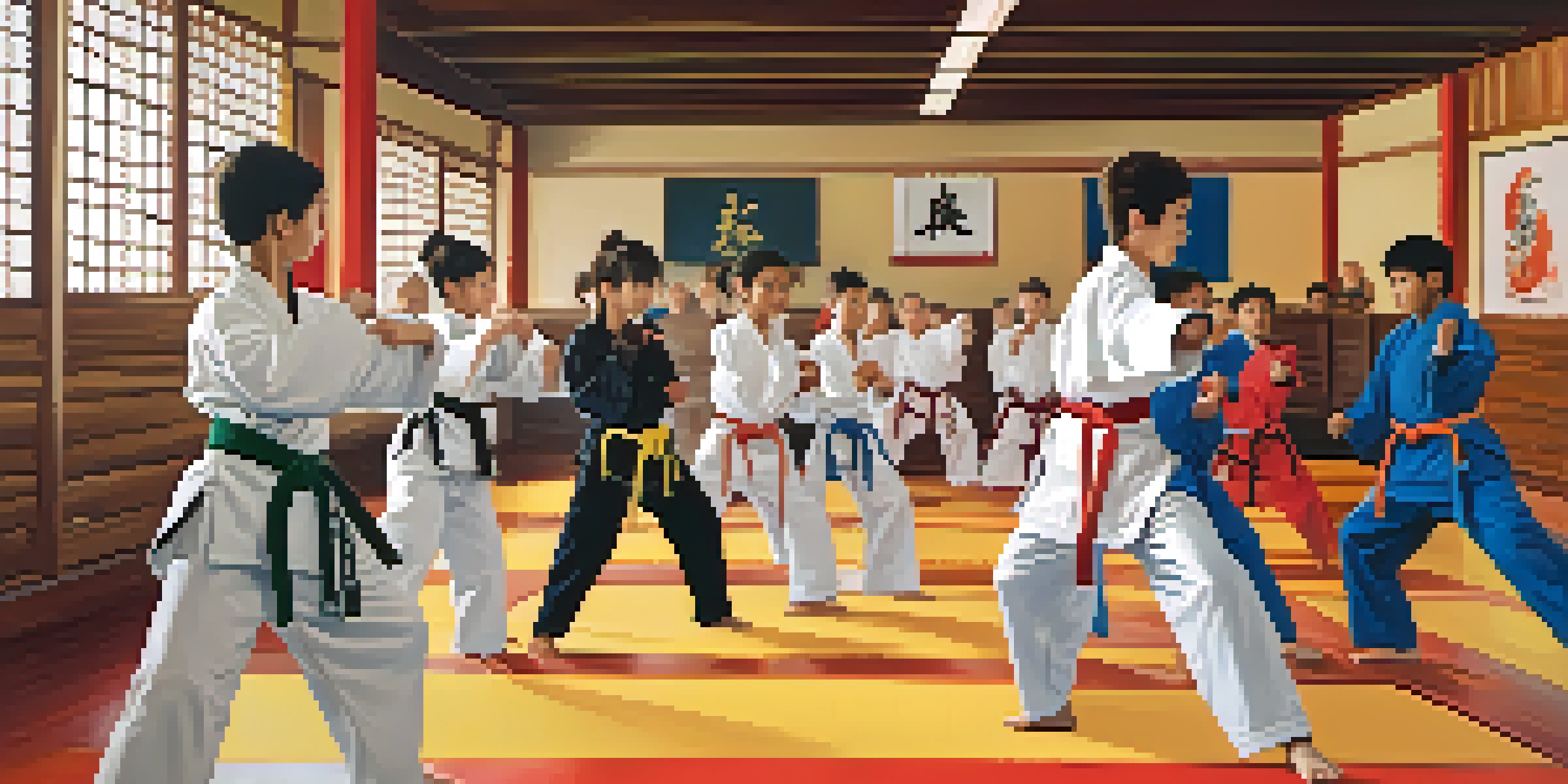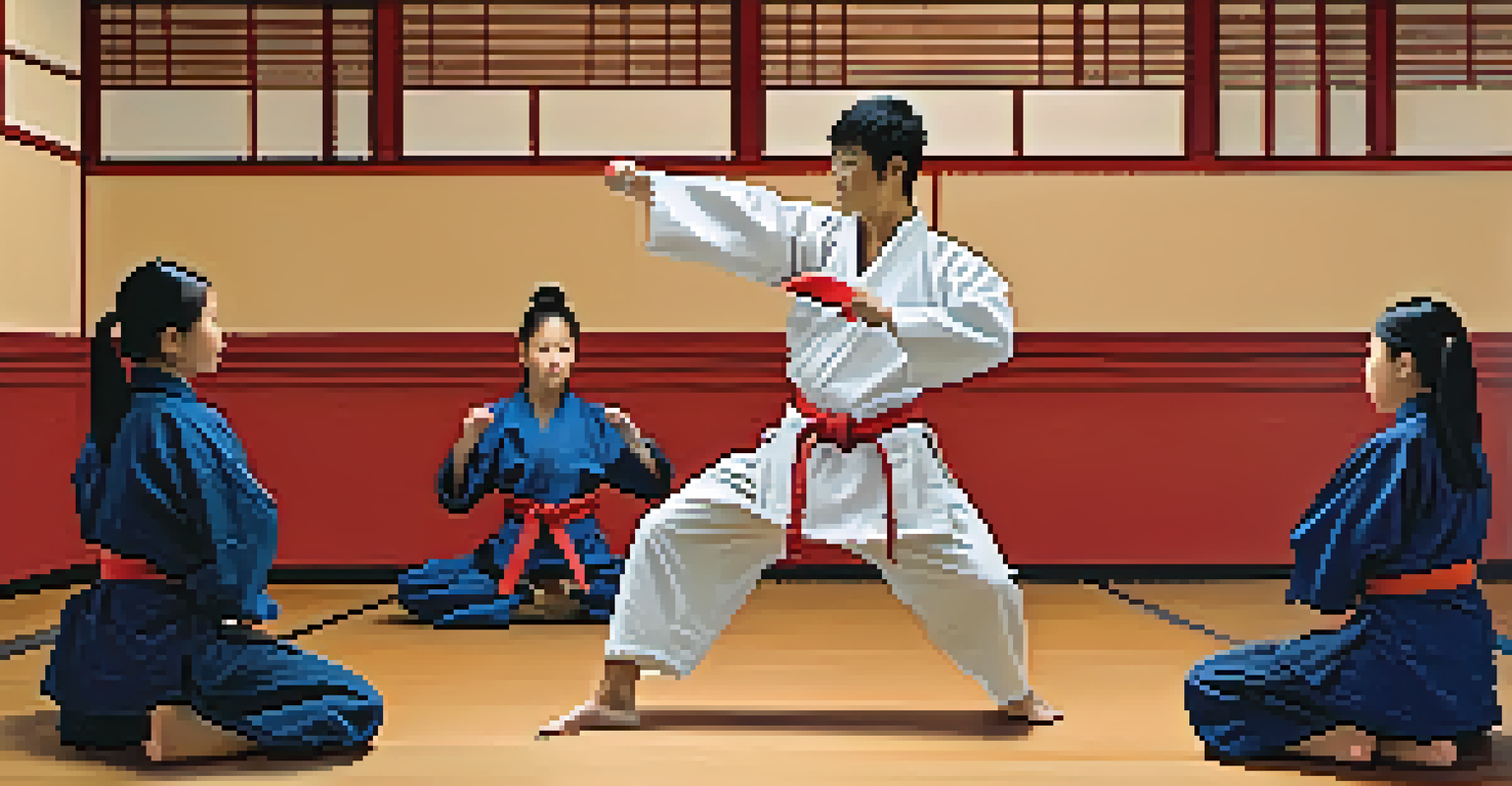Empowering Youth: Martial Arts as a Bullying Prevention Tool

Understanding the Bullying Landscape Among Youth
Bullying is a pervasive issue that affects countless young people, manifesting in physical, verbal, and emotional forms. Statistics reveal that nearly one in five students experiences bullying at school, making it essential to address this concern head-on. Understanding the dynamics of bullying helps parents, educators, and peers recognize the signs and take action to foster a supportive environment.
The greatest glory in living lies not in never falling, but in rising every time we fall.
The impact of bullying can be long-lasting, influencing a child's self-esteem, mental health, and overall well-being. Victims often feel isolated, which can lead to anxiety and depression. Creating an awareness around bullying is the first step in implementing effective prevention strategies that empower youth to stand strong against this behavior.
Martial arts offer a unique approach to combating bullying, equipping young people with tools to navigate these challenges. By fostering self-confidence and resilience, martial arts provide a foundation for youth to develop both physically and mentally, preparing them to face adversities head-on.
How Martial Arts Build Confidence in Youth
One of the most significant benefits of martial arts training is the boost in self-confidence it provides. As students learn new techniques and achieve belts, they experience a sense of accomplishment that translates into other areas of their lives. This newfound confidence can deter potential bullies, as individuals who stand tall and self-assured are less likely to be targeted.

In martial arts classes, students often face challenges, whether mastering a difficult move or sparring with a partner. These experiences teach resilience and perseverance, valuable traits that help them navigate not just bullying situations but also the ups and downs of life. The supportive community within martial arts further reinforces a sense of belonging, crucial for personal growth.
Martial Arts Build Youth Confidence
Training in martial arts boosts self-confidence, helping youth deter potential bullies and navigate life's challenges.
Beyond physical skills, martial arts instill a mindset of respect and discipline. Practitioners learn to respect their instructors, peers, and themselves, fostering an environment where bullying is less likely to thrive. This shift in mindset empowers youth to stand up against bullying, both personally and on behalf of others.
Developing Self-Defense Skills in Martial Arts
Martial arts training emphasizes self-defense, teaching students how to protect themselves physically if needed. While it's essential to promote non-violent conflict resolution, knowing self-defense can provide a significant psychological advantage. Youth who feel capable of defending themselves are less likely to feel helpless in the face of bullying.
Courage is not the absence of fear, but the triumph over it.
Techniques learned in martial arts are not just about physical strength; they also focus on awareness and de-escalation. Students are trained to recognize potentially dangerous situations and respond appropriately, often diffusing conflicts before they escalate. This proactive approach empowers youth to handle bullying situations with confidence and strategy.
Moreover, self-defense training helps youth understand the importance of using their skills responsibly. Martial arts instills a code of ethics that encourages students to avoid unnecessary confrontation and to seek peaceful resolutions. This balance between assertiveness and responsibility is essential in cultivating a culture of respect and support among peers.
Fostering a Sense of Community Through Martial Arts
Martial arts schools often cultivate a strong sense of community, where students support and uplift one another. This environment encourages camaraderie and teamwork, essential elements for any youth facing bullying. When students feel connected to their peers, they're more likely to speak up against bullying and support one another in difficult situations.
In these communities, students learn to celebrate each other's successes, which fosters an inclusive atmosphere. By promoting values such as teamwork and mutual respect, martial arts practitioners develop empathy and compassion, qualities that counteract bullying behavior. This positive reinforcement creates a ripple effect that can transform school culture.
Community Supports Anti-Bullying
Martial arts schools foster a sense of community, encouraging students to stand up against bullying and support one another.
Additionally, many martial arts schools engage in community outreach and anti-bullying programs, extending their impact beyond the dojo. These initiatives not only raise awareness about bullying but also provide young people with the tools and resources to address it effectively. Through collaboration, martial arts communities empower youth to be advocates for change.
Teaching Conflict Resolution in Martial Arts Classes
Martial arts classes often incorporate lessons on conflict resolution, equipping youth with the skills to manage disputes peacefully. Students learn that physical confrontation is not always the answer; instead, communication and negotiation can often lead to better outcomes. This understanding is crucial in a world where bullying can escalate quickly.
By practicing scenarios that involve conflict resolution, youth gain confidence in their ability to handle tough situations. They learn to assess conflicts critically and explore various ways to respond, empowering them to make thoughtful decisions. This skill set is invaluable, not just in addressing bullying but in all aspects of life.
Incorporating these lessons into martial arts training reinforces the idea that true strength lies in self-control and wisdom. As students learn to approach conflicts calmly and rationally, they become role models for their peers, demonstrating that violence is not the solution. This approach fosters a culture of respect and understanding, making it less likely for bullying to occur.
The Role of Instructors in Empowering Youth
Martial arts instructors play a pivotal role in shaping the experiences of their students. They not only teach techniques but also instill values such as respect, discipline, and perseverance. A positive instructor can inspire youth to believe in themselves and their capabilities, which is crucial in combating bullying.
Instructors often serve as mentors, providing guidance and support to students facing bullying challenges. By creating an open environment where students feel safe to share their experiences, instructors can offer valuable advice and strategies. This mentorship can make a significant difference in a young person's life, empowering them to take action against bullying.
Effective Conflict Resolution Skills
Martial arts classes teach youth to manage disputes peacefully, equipping them with the skills to handle bullying situations thoughtfully.
Moreover, instructors can lead by example, demonstrating how to handle conflicts with grace and dignity. By modeling appropriate behavior, they reinforce the idea that strength comes from within, not through aggression. This holistic approach to teaching martial arts provides youth with the tools they need to navigate the complexities of social interactions.
Encouraging Youth to Speak Up Against Bullying
Empowering youth involves encouraging them to be vocal about their experiences and to speak up against bullying. Martial arts training promotes self-expression, helping students articulate their feelings and concerns in a constructive manner. This ability to communicate effectively is crucial when addressing bullying situations, whether they are victims or witnesses.
Creating a culture of openness within martial arts schools allows students to share their experiences without fear of judgment. Instructors can facilitate discussions about bullying, emphasizing the importance of standing up for oneself and others. This dialogue not only raises awareness but also fosters a sense of solidarity among students.

When youth feel empowered to speak out, they contribute to a larger movement against bullying. By sharing their stories, they inspire others to take action and create a ripple effect of change within their communities. This collective effort can significantly impact the overall environment, making it less conducive to bullying behavior.